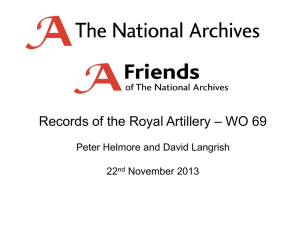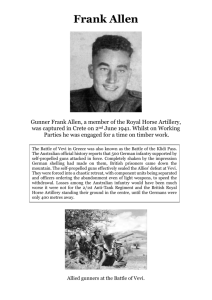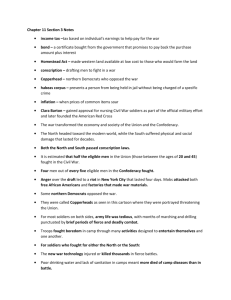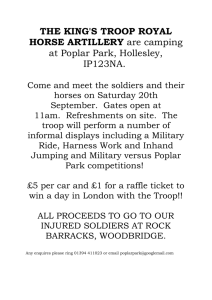Civil War Field Artillery Civil War artillery was somewhat limited to
advertisement
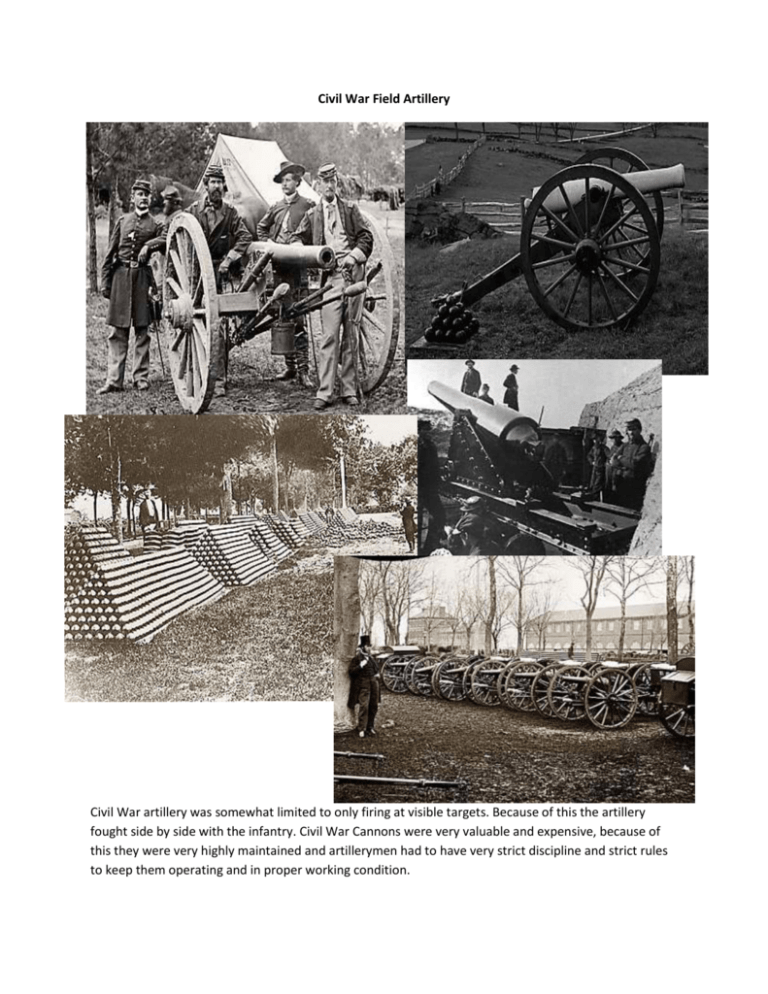
Civil War Field Artillery Civil War artillery was somewhat limited to only firing at visible targets. Because of this the artillery fought side by side with the infantry. Civil War Cannons were very valuable and expensive, because of this they were very highly maintained and artillerymen had to have very strict discipline and strict rules to keep them operating and in proper working condition. World War I Field Artillery The artillery of World War I was used to counter the trench warfare that set in shortly after the conflict commenced, and was an important factor in the war, influencing its tactics, operations and incorporated into strategies that were used by the belligerents to break the stalemate at the front. World War I raised artillery to a new level of importance on the battlefield. Artillery proved the number one threat to infantry and tanks alike and came in several light, medium and heavy forms. Civil War Guns Before the Civil War, infantry soldiers typically carried muskets that held just one bullet at a time. The range of these muskets was about 250 yards. Rifles, by contrast, had a much greater range than muskets did--a rifle could shoot a bullet up to 1,000 yards-and were more accurate. The Civil War bullet caused tremendous casualties and incredible suffering to many brave soldiers. Wartime field hospitals reports indicated that as much as ninety percent of battle wounds were caused by small arms projectiles. World War I Guns Machine Guns are repeating firearms that when triggered will load and fire automatically until their ammunition is exhausted. The 1914 machine gun, usually positioned on a flat tripod, would require a gun crew of four to six operators. In theory they could fire 400-600 small-caliber rounds per minute, a figure that was to more than double by the war's end, with rounds fed via a fabric belt or a metal strip. The pistol, originally designed as a cavalry weapon, was the staple weapon for a variety of personnel during World War One (and beyond). Civil War Battlefield At least 618,000 Americans died in the Civil War, and some experts say the toll reached 700,000. The number that is most often quoted is 620,000. At any rate, these casualties exceed the nation's loss in all its other wars, from the Revolution through Vietnam. There were long stretches of boredom in camp interspersed with moments of sheer terror experienced on the battlefield. World War I Battlefield The Great War was fought on so many fronts, with single battles often fought across tens of miles. The First World War was typified however by its lack of movement. Trench warfare soon set in. Death was a constant companion to those serving in the line, even when no raid or attack was launched or defended against. The life of a soldier in World War I can be summed up in one word, hard. Civil War Medical Care Nineteenth-century medicine was ill-prepared to deal with war. At the time of the Civil War, most medical treatment was not only unhelpful but could actually be harmful. There were at least twice as many deaths from disease as from combat-related injuries during the Civil War. Opium and its derivatives were commonly used for pain. By the latter part of the war, both Union and Confederate soldiers enjoyed generally good health. The weak had died or gone home, while the remainder developed natural immunities either by surviving disease or being vaccinated. World War I Medical Care Upon the outbreak of World War I (1914-1918), the medical services were not really prepared for the type of war they were about to become bogged down in. If you were unlucky enough to have been shot in the femur in 1914, you had about an 80 per cent chance of death. By 1917 your chances would have completely flipped to an 82 per cent chance of survival. Great advances in prostheses were made. Gunshot wounds were now irrigated with antiseptic fluid, which helped prevent gangrene. Most importantly, hygiene became an ever-present issue. Civil War Naval Technology The Civil War ushered in a number of advances in naval technology beyond the use of ironclads, including gains in mine, torpedo and artillery design, as well as the first-time use of a submarine to sink an enemy ship. Usually thought of as a land war, the American Civil War was also by far the largest naval war of the era. The naval war was one of sudden, spectacular lightning battles. This part of the war -- the sea war -- is often forgotten, but it was important. The Union victory might not have been possible without the successes of its navy. World War I Naval Technology Major Warship Strengths Navies Warship types Battleships Carriers Cruisers Destroyers Submarines Totals Royal Navy Home waters (a) Atlantic (b) French Navy Atlantic and Channel German Navy European waters Atlantic station 9 4 21 82 21 137 14 13 4 31 2 1 3 20 26 3 7 22 41(d) 73 2(c) 16 18 plus escorts - - plus torpedo boats - Trench warfare on the Western Front may have captured the popular imagination, but the First World War was very much a maritime conflict as well. While the navies of the First World War rarely met in large engagements, still they played a crucial role in the course of the war. Surface fleets were dominated by the battleships. The German U-Boats became the primary weapon of the German Navy. Because submarines were spending more time underwater, destroyers were outfitted with devices known as hydrophones, which gave them a chance to detect subs lurking nearby. When they were found, explosive canisters known as depth charges were rolled off the back of the destroyer, with luck exploding near the enemy submarine. Even if the sub were not destroyed, it might be damaged. Civil War Soldiers As brother fought brother and the nation's future grew uncertain, the public appetite for information was fed by these images. Of the 2 million soldiers and sailors who fought for the Union during the Civil War, 180,000 were African Americans. The first all-African-American regiment was the 54th Massachusetts Infantry. Like the men, there were women who lived in camp, worked as nurses, suffered in prisons, and died for their respective causes. World War I Soldiers World War I (also known as the Great War) began in June of 1914. The first war that allowed women to openly serve in the army was World War I. Over 30 thousand women served as nurses during WWI. The nurses of WWI worked on the front line, picking up the wounded soldiers. World War I also marked a turning point for black soldiers, on the battlefield. Over 200,000 African-Americans fought in France. But none of them fought alongside white American troops. Instead, the fully segregated black units fought with the French Army and took orders from French commanders. At war's end, over 600 AfricanAmericans had been commissioned as officers, a rank denied to them before the war.
